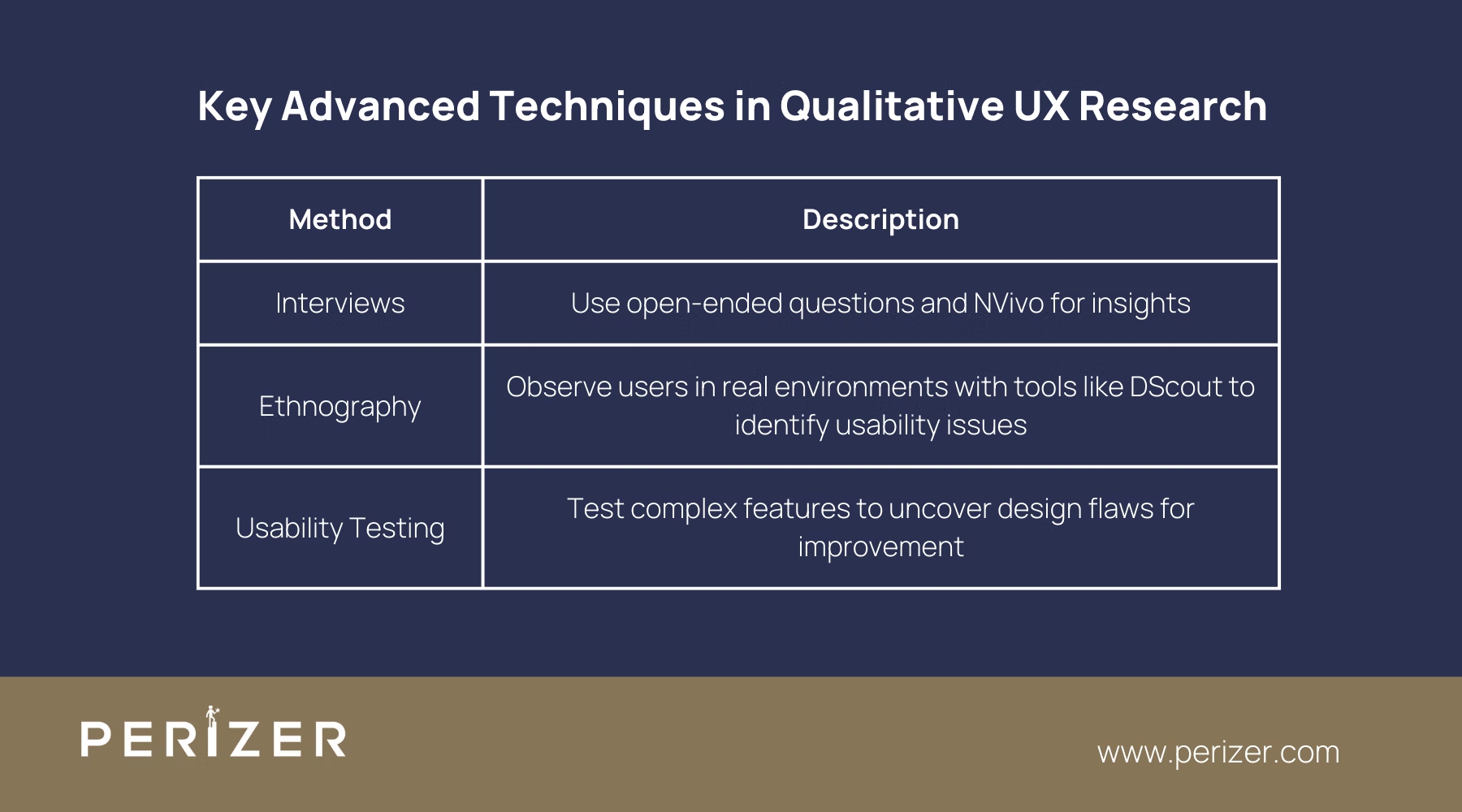A Guide to Qualitative vs Quantitative UX Research Methods
Learn how to integrate qualitative and quantitative UX research methods to gain deeper insights and make smarter, data-driven design decisions for better user experiences.

Getting real insights from UX research isn’t just about collecting data - it’s about understanding your users on a deeper level. Qualitative research lets you get into the emotions, motivations, and behaviors behind user actions, while quantitative methods give you the numbers to back up those insights. When you combine both, your research transforms into a solid strategy that drives better design decisions.
With qualitative techniques like interviews and ethnography, you’ll capture the real-world context and depth that numbers can’t reveal. Quantitative methods like A/B testing and funnel analysis give you the metrics to track and fine-tune those insights across your user base.
Let’s explore in this guide how to combine both methods for a stronger UX approach, helping you confidently use them to make more informed, data-driven design decisions.
Foundational Differences: Qualitative vs. Quantitative UX Research

Qualitative research goes beyond surface-level data to explore the deeper motivations, emotions, and context behind user behavior. It helps you capture the subtleties that numbers alone can’t, offering rich insights through methods like in-depth interviews and contextual inquiries. This approach allows you to uncover hidden patterns and pain points, giving you a more comprehensive understanding of the user experience.
Quantitative research, in contrast, provides clear, measurable data that can be scaled across a broader audience. It’s essential for validating the trends you’ve identified through qualitative research, giving you concrete metrics to back up your findings. With quantitative insights, you can make more confident design decisions, knowing they’re supported by statistically significant data.
How to Identify When to Use Which Methodology?
Deciding whether to use qualitative or quantitative research is about understanding the specific goals of your project and where you are in the design process. In the exploratory stage, when you're trying to dig into user motivations, behaviors, and pain points, qualitative research is key. It gives you deep insights into the emotions and thought processes behind user actions, helping you understand the “why” behind what users are doing.
As you move to the evaluation or validation stage, that’s where quantitative research comes in. Here, you need to confirm whether the trends and insights you uncovered in your qualitative research hold true across a broader audience. Quantitative data gives you the numbers and statistical evidence to support your design decisions and ensure they apply to a larger user base.
The best UX research doesn’t treat these methods as separate. When you combine qualitative insights with quantitative validation, you get a well-rounded understanding of your users, leading to smarter, more informed design choices throughout your project.
Advanced Approaches to Qualitative UX Research
The depth of your qualitative research depends on how well you plan and execute each method. Here, we’ll explore advanced techniques that can take your research to the next level.

1. Conducting In-Depth User Interviews
Effective user interviews don’t just happen - they require careful preparation well before you sit down with participants. It’s essential to create thoughtful, open-ended questions that encourage users to share meaningful details about their experiences.
Avoid shallow questions and instead focus on exploring their underlying behaviors and decision-making processes. Incorporating cognitive walkthroughs can add extra value, allowing users to talk through their actions as they engage with your product.
After collecting responses, organizing the wealth of data becomes key. Advanced coding techniques help you group responses by themes, behaviors, and sentiments, making it easier to spot trends. Tools like NVivo or Atlas.ti allow you to scale this process, so you're not just left with anecdotal information but actionable insights that guide your design decisions.
2. Ethnographic Research and Contextual Inquiry
Ethnographic research is invaluable when you want to observe how users interact with your product in their real environments. While traditional ethnography happens in physical spaces, digital ethnography has become more accessible with tools like DScout and Lookback. These platforms allow you to remotely observe users in natural settings, capturing how they use your product in everyday scenarios without disruption.
The strength of ethnography lies in observing users naturally without interference. This approach uncovers real challenges and workarounds, revealing usability gaps that structured testing might overlook. Once collected, these insights should be turned into actionable design improvements, such as refining navigation or simplifying interactions.
3. Advanced Usability Testing Techniques
Usability testing is a go-to method in UX, but it can be refined for greater impact. Start by designing your test scenarios around specific hypotheses, rather than generic tasks. Focus on challenging users to explore lesser-known or more complex features of your product. This will help uncover hidden usability issues that might go unnoticed in simpler tests.
When moderating sessions, it’s important to guide without interfering. Ask strategic questions that prompt users to reflect on their experience, but do so without disrupting their natural flow. Afterward, dive deep into the patterns emerging from the sessions, focusing on systemic issues that affect multiple users. The goal here is to pinpoint design flaws that persist across users, driving meaningful design iterations rather than addressing one-off problems.
Mastering Quantitative UX Research
Quantitative research demands precision, ensuring that the data you collect is statistically sound and actionable. It's about gathering numbers that inform design, not just collecting data for the sake of it.
1. A/B Testing and Multivariate Testing
When setting up an A/B test, attention to detail is critical. Start with a well-defined hypothesis - what specific design element are you testing, and what outcome are you targeting? For more advanced scenarios, multivariate testing is key, allowing you to test multiple variables at once to see how they interact. However, careful planning is required to avoid statistical noise that can obscure meaningful results.
Next, determining the correct sample size is essential. Too small, and your results lack reliability; too large, and you're wasting resources. Use statistical models to calculate the optimal sample size, ensuring that your findings are both valid and efficient.
Finally, don’t stop at just conversion rates. Dig deeper into the user journey. Identify behavioral shifts or patterns among different user segments, providing a more granular understanding of how design changes affect user experience.
2. Heatmaps, Clickstream Analysis, and Funnel Analysis
Heatmaps and clickstream analysis are staples of advanced quantitative research. Heatmaps reveal where users are interacting with your page, but the true value comes from combining this data with qualitative insights. For instance, if users are drawn to non-clickable elements, it signals a design issue, not just an engagement metric.
Clickstream analysis broadens the view, showing the entire user flow through your product. Advanced path analysis helps you understand both typical and alternative journeys, shedding light on areas where users deviate or drop off. These insights are essential for refining navigation and improving user retention.
3. Measuring UX Metrics: Task Success Rate, Time on Task, and More
Selecting the right metrics is key to meaningful quantitative research. Task success rate and time on task are useful but should align with the complexity of your product. For non-linear user journeys, segmenting users by their paths can yield more relevant insights than averages. Benchmarking these metrics across product versions lets you track how design changes affect usability, helping refine current designs and inform future improvements.
Integrating Qualitative and Quantitative UX Research
The real strength in UX research comes from blending qualitative and quantitative methods. Use qualitative insights to shape your quantitative analysis—if users mention frustration with navigation during interviews, a heatmap analysis can confirm if it’s a widespread issue.
Likewise, if an A/B test shows a drop in conversions for a particular user group, follow up with interviews to uncover the underlying cause. This approach gives you a more complete view of user behavior, making your findings both deeper and more actionable.
Tools to Empower Your UX Research Workflow
There are plenty of tools out there for UX research, but the real challenge is using them in a way that delivers meaningful results. Tools like Lookback and Optimal Workshop help you gather both qualitative and quantitative insights, making your process faster and more efficient.
The key is to weave these tools into a seamless workflow. For instance, you can use Hotjar to capture heatmap data, then follow up with in-person usability testing to get deeper, more detailed feedback.
Conclusion
Mastering both qualitative and quantitative UX research is essential for refining your design process. Knowing how these methods work together lets you uncover deeper insights into what drives your users - their needs, behaviors, and motivations.
It’s not just about gathering data; it’s about using that data to make smarter, more user-focused design choices that truly improve the product.
FOCUSED, FAST, GOVERNMENT READY
Stay Tuned With Our Latest Insights

Staff Augmentation
Learn how to select the perfect IT outsourcing partner to promote your team’s capabilities, improve productivity, and drRead more...

Staff Augmentation
Find the perfect staff augmentation partner by aligning your goals, evaluating expertise, managing costs, and ensuring aRead more...

Cyber Security
We focus on understanding the needs, behaviors, and expectations of your users through extensive user research. This infRead more...